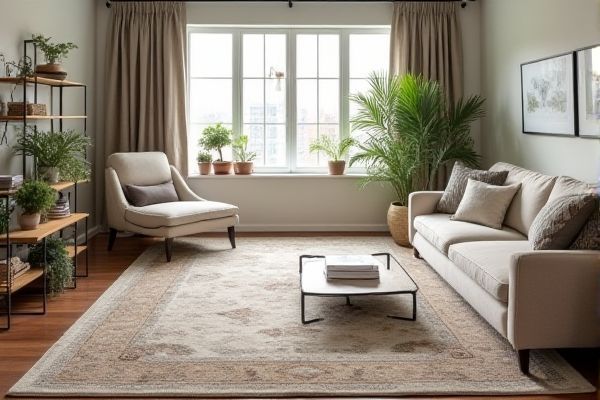
Area rugs provide versatile coverage for living spaces, adding warmth and style to entire rooms, while runner rugs are narrow and long, ideal for hallways or stairs where you need protection without blocking traffic flow. Discover which rug best suits Your space and lifestyle by reading the rest of this article.
Table of Comparison
| Feature | Area Rug | Runner Rug |
|---|---|---|
| Definition | A larger rug covering a defined area of a room | A long, narrow rug designed for hallways or stairs |
| Typical Size | 5x8 ft, 8x10 ft, or larger | 2x6 ft, 2x8 ft, 2x10 ft |
| Common Use | Living rooms, bedrooms, dining areas | Hallways, corridors, entryways, staircases |
| Shape | Varies: rectangular, square, round | Always rectangular and long |
| Functionality | Defines seating areas, adds warmth and style | Protects floor in narrow spaces, guides foot traffic |
| Placement | Centered under furniture or open space | Along narrow pathways or stairs |
| Design Variety | Wide range of patterns, colors, textures | Focused on durability and slip resistance |
Understanding Area Rugs and Runner Rugs
Area rugs cover larger floor spaces and add warmth and style to living rooms, dining areas, or bedrooms, while runner rugs are long and narrow, designed primarily for hallways, stairs, or entryways. Your choice depends on space size and functionality; area rugs anchor furniture and define rooms, whereas runner rugs protect high-traffic paths and add visual continuity. Understanding these differences helps you select the perfect rug to enhance both aesthetics and practicality in your home.
Key Differences Between Area Rugs and Runner Rugs
Area rugs typically cover a larger floor space in living rooms or dining areas, offering wide coverage and decorative impact, while runner rugs are long and narrow, designed primarily for hallways or staircases to provide foot traffic protection and accentuate narrow spaces. The dimensions of area rugs usually range from 5x8 to 9x12 feet, whereas runner rugs commonly measure 2-3 feet in width and 6-14 feet in length. Materials vary but both types often utilize wool, synthetic fibers, or blends, with pile height and pattern choices tailored to the specific room function and aesthetic needs.
Ideal Placement for Area Rugs
Area rugs are ideal for defining larger spaces such as living rooms, dining areas, and bedrooms, where they anchor furniture and add warmth. Runner rugs are best suited for narrow or high-traffic areas like hallways, staircases, and entryways, providing protection and visual continuity. Choosing the right rug based on room size and layout ensures optimal aesthetic appeal and functionality.
Best Uses for Runner Rugs
Runner rugs are ideal for narrow, high-traffic spaces such as hallways, staircases, and entryways, providing both protection and aesthetic appeal. Their elongated shape helps to visually extend the length of a room or corridor, creating a cohesive flow in interior design. Runner rugs also offer cushioning underfoot, reducing noise and enhancing safety on slippery surfaces.
Materials and Construction Comparison
Area rugs typically feature dense pile surfaces made from wool, synthetic fibers, or natural materials like jute, offering durability and rich textures suited for larger spaces. Runner rugs are often constructed with thinner, more flexible materials such as cotton or synthetic blends, allowing for easy placement in narrow, high-traffic areas like hallways or staircases. Your choice between an area rug and a runner rug should consider the material's resilience and construction style to match both the functional needs and aesthetic preferences of your space.
Style and Design Options
Area rugs offer a wide variety of styles, patterns, and colors, making them ideal for defining spaces and adding a focal point in larger rooms. Runner rugs, designed for narrow spaces like hallways or staircases, often feature elongated designs and repetitive patterns that enhance flow and continuity. Your choice depends on the space's size and desired aesthetic impact, balancing bold statements with subtle accents.
Sizing and Dimensions Guide
Area rugs typically range from 5x8 feet to 9x12 feet, designed to cover larger spaces like living rooms or bedrooms, while runner rugs are narrower, usually 2 to 3 feet wide and 6 to 14 feet long, ideal for hallways and staircases. When selecting sizes, area rugs should complement the furniture arrangement by extending beyond the edges, whereas runner rugs require precise length to fit corridor dimensions without overcrowding. Proper sizing ensures balanced aesthetics and functionality, preventing trips and maintaining cohesive room flow.
Cleaning and Maintenance Tips
Area rugs require regular vacuuming and spot cleaning to maintain their appearance, with deep cleaning recommended every 12-18 months depending on foot traffic. Runner rugs, often placed in high-traffic hallways, benefit from frequent vacuuming and occasional professional cleaning to prevent dirt buildup and wear. Both types should be rotated periodically to ensure even wear and avoid fading in sunlight-exposed areas.
Cost Considerations: Area Rugs vs. Runner Rugs
Area rugs generally cost more than runner rugs due to their larger size and greater material requirements, with prices varying based on fiber type, design complexity, and brand. Runner rugs, being narrower and longer, often provide a budget-friendly option for hallways or stairs while maintaining aesthetic appeal. Choosing between an area rug and a runner rug depends on the specific space dimensions and desired coverage, influencing overall expenses significantly.
How to Choose the Right Rug for Your Space
Choosing the right rug for your space requires assessing the size and function of the area where the rug will be placed. Area rugs work best in living rooms or dining areas where they can anchor furniture and define zones, typically measuring between 5x8 to 9x12 feet. Runner rugs are ideal for narrow or high-traffic spaces like hallways and staircases, usually ranging from 2 to 3 feet wide and 6 to 14 feet long, providing protection and style without overwhelming the space.
 homyna.com
homyna.com